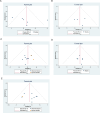Effects of nitrate supplements on cardiopulmonary fitness at high altitude: A meta-analysis of nine randomized controlled trials
- PMID: 40202971
- PMCID: PMC11981189
- DOI: 10.1371/journal.pone.0319667
Effects of nitrate supplements on cardiopulmonary fitness at high altitude: A meta-analysis of nine randomized controlled trials
Abstract
Background: Nitrate is a dietary intervention commonly used to enhance exercise capacity, including cardiopulmonary fitness, yet its effectiveness has been recently questioned at high altitudes. This meta-analysis systematically evaluates the effects of dietary nitrate supplements on cardiopulmonary fitness at high altitude, as reflected in the biomarker of cardiopulmonary fitness, paving the way for informed dietary strategies.
Methods: We conducted a systematic assessment and meta-analysis of randomized controlled trials to examine the effects of dietary nitrate supplementation on biomarkers of cardiorespiratory health at high altitude. Studies were included if they involved healthy individuals (≥16 years of age) engaging in endurance activities such as hiking, long-distance running, mountain climbing, or bicycling at high altitude. Outcomes of interest included nitrite levels (NO2-), maximal oxygen uptake (VO2max), heart rate (HR), perceived exertion (RPE), and pulse oxygen saturation (SpO2). Exclusion criteria included duplicate publications, non-human studies, studies with missing data that could not be retrieved, non-randomized clinical trials, and non-original research articles such as conference papers, expert consensus, or reviews. Our search for articles was conducted across PubMed, Scopus, Web of Science, and Embase, without any language restrictions. A random effects model was employed for quantitative data analysis, utilizing Standardized Mean Difference (SMD) and 95% confidence intervals as summary statistics. The methods and results were reported according to the PRISMA2020 statement.
Results: A total of 9 studies with a sample size of 161 cases were included in the analysis. The meta-analysis indicated that dietary nitrate supplement significantly elevated NO2- concentration (95% CI: 1.38 to 3.12; SMD = 2.25, P < 0.00001; I2 = 70%). However, there was no significant effect observed on VO2max (95% CI: -0.58 to 0.23; SMD = -0.17, P = 0.76; I2 = 0%), HR (95% CI: -0.31 to 0.23; SMD = -0.04, P = 0.77; I2 = 0%), RPE scores (95% CI: -0.49 to 0.18; SMD = -0.16, P = 0.36; I2 = 0%), and SpO2 percentage (95% CI: -0.36 to 0.20; SMD = -0.08, P = 0.58; I2 = 0%).
Conclusions: The current meta-analysis indicates that dietary nitrate intake is less correlated with cardiopulmonary fitness at high altitudes, and further research is required to clarify its impact on exercise capacity.
Copyright: © 2025 Kang et al. This is an open access article distributed under the terms of the Creative Commons Attribution License, which permits unrestricted use, distribution, and reproduction in any medium, provided the original author and source are credited.
Conflict of interest statement
The authors have declared that no competing interests exist.
Figures




Similar articles
-
The effects of dietary nitrate supplementation on endurance exercise performance and cardiorespiratory measures in healthy adults: a systematic review and meta-analysis.J Int Soc Sports Nutr. 2021 Jul 9;18(1):55. doi: 10.1186/s12970-021-00450-4. J Int Soc Sports Nutr. 2021. PMID: 34243756 Free PMC article.
-
Effect of nitrate supplementation on oxygen saturation levels for acute mountain sickness prevention: A systematic review and meta-analysis.Nitric Oxide. 2024 Sep 1;150:27-36. doi: 10.1016/j.niox.2024.07.003. Epub 2024 Jul 11. Nitric Oxide. 2024. PMID: 39002891
-
Effect of Acute Dietary Nitrate Consumption on Oxygen Consumption During Submaximal Exercise in Hypobaric Hypoxia.Int J Sport Nutr Exerc Metab. 2016 Aug;26(4):315-22. doi: 10.1123/ijsnem.2015-0144. Epub 2015 Dec 2. Int J Sport Nutr Exerc Metab. 2016. PMID: 26630309 Clinical Trial.
-
Dietary nitrate supplementation increases acute mountain sickness severity and sense of effort during hypoxic exercise.J Appl Physiol (1985). 2017 Oct 1;123(4):983-992. doi: 10.1152/japplphysiol.00293.2017. Epub 2017 Jul 6. J Appl Physiol (1985). 2017. PMID: 28684588
-
Dietary nitrate supplementation to enhance exercise capacity in patients with COPD: Evidence from a meta-analysis of randomized controlled trials and a network pharmacological analysis.Respir Med. 2024 Feb;222:107498. doi: 10.1016/j.rmed.2023.107498. Epub 2023 Dec 28. Respir Med. 2024. PMID: 38158139
References
-
- Li C, Li X, Liu J, Fan X, You G, Zhao L, et al.. Investigation of the differences between the Tibetan and Han populations in the hemoglobin-oxygen affinity of red blood cells and in the adaptation to high-altitude environments. Hematology. 2018;23(5):309–13. doi: 10.1080/10245332.2017.1396046 - DOI - PubMed
-
- Mu S, Kong M, Wang H, Chang H, . Study on 5-km Armed Cross-Country Training in the Plateau Hypoxic Environment. Man-Machine-Environment System Engineering: Proceedings of the 18th International Conference on MMESE 18. Springer; 2019.
Publication types
MeSH terms
Substances
LinkOut - more resources
Full Text Sources
Medical

